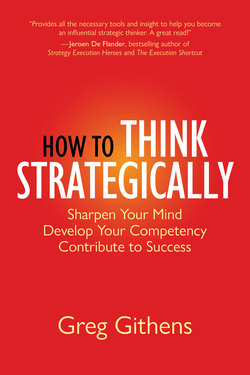Читать книгу How to Think Strategically - Greg Githens - Страница 11
На сайте Литреса книга снята с продажи.
ОглавлениеPART I
The Nature, Purpose, and Scope of Strategic Thinking
PART I DESCRIBES the nature, purpose, and scope of strategic thinking. You will learn that strategic thinking is not a system of subsystems but rather a loosely integrated cluster of concepts. I suggest reading the nine chapters in order, since early chapters establish principles and examples that are further developed in subsequent chapters.
Chapter 1 (Are You Strategic?) introduces ambiguity as a fundamental challenge that is usually neglected in the work to craft strategy. I introduce the strategic-thinking narrative technique and apply it to Billy Beane and the Moneyball strategy. The narrative reveals the importance of confronting the reality of a dire situation, of being curious in seeking new strategic logics, and of coordinating the organization during implementation. The chapter concludes by encouraging readers to adopt the beginner’s mind.
Chapter 2 (Cleverness) shows that using adjectives like good or clever allow you to better characterize the quality of a strategy. I return to the Billy Beane Moneyball story to show that it was clever because a relatively weak organization was able to accomplish brilliant results. I introduce one of the most popular and effective tools in the book, the five-part template for writing strategy.
Chapter 3 (Big Ideas) uses the Christopher Columbus strategic-thinking narrative to reveal essential principles of competent strategic thinking. This includes a four-pillar definition of strategic thinking, the four X-factors, and six important lessons for Columbus’s success with his big idea.
Chapter 4 (Twelve Microskills of Strategic Thinking) introduces a set of specific conceptual skills. As you make the microskills of strategic thinking a habit of mind, you will improve your capacity for thinking strategically. If you adopt only one thing from this book, I recommend practicing the Ben Franklin technique to highlight and practice one microskill each week.
Chapter 5 (Why Strategic Thinking is Rare) explains that strategic thinking is rare because individuals tend to pay attention to the map of operational thinking. The prevailing culture enhances that attention. The consequence is that operational thinking tends to crowd aside strategic thinking. The path to better strategic thinking is to orient yourself toward the navigational beacons of the core challenge, the future, and insights. This chapter introduces the microskills of devalorization and contrarianism to help you distance yourself from the map of operational thinking.
Chapter 6 (The Fuzzy Front End of Strategy) introduces the strategy funnel, which is a three-phase framework. The first of the three phases is the fuzzy front end of strategy. It involves sensing and interpreting weak signals. The strategist then practices sensemaking and synthesis, resulting in a set of beliefs about the situation. The second phase is the structured back end. It’s here that the strategist identifies a core challenge, the dominating ideas of strategy, and makes strategic decisions. The third phase involves programming. It is the application of resources and methods to address that core challenge. This chapter introduces the microskills of high-quality questions and abductive reasoning.
Chapter 7 (Pockets of the Future) introduces the idea that you can find weak signals in the present that have significant implications for the future. Things that we presently consider curiosities can become dominant in future systems. You will find useful the three horizons framework for describing the dynamics of qualitative change in future systems. This chapter introduces the microskill of anticipation. Strategic thinkers must be oriented toward the future and consider their anticipatory assumptions.
Both Chapter 8 (Strategic Decisions) and Chapter 9 (The Spark of Insight) feature the strategic-thinking narrative of Lou Gerstner and his time as CEO of IBM, when he led the company’s turnaround and transformation. Chapter 8 explains the criteria for strategic decisions and tactical decisions, using Gerstner’s decision to keep IBM together as an example of a strategic decision. The chapter also provides another example of written strategy using the five-part model similar to that provided in Chapter 2. Insights are the secret sauce of strategy, and Chapter 9 unpacks its mechanisms. The chapter introduces the microskill of reframing and suggests techniques for increasing the quantity and quality of insights.
